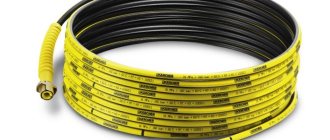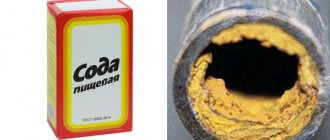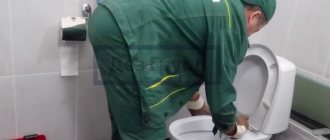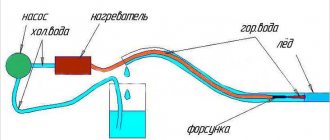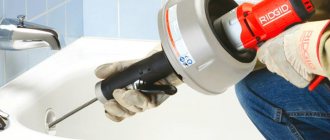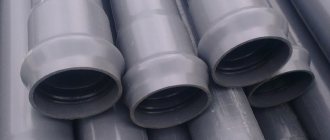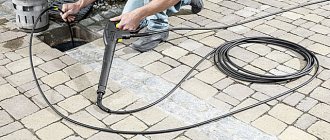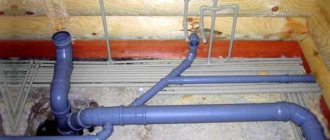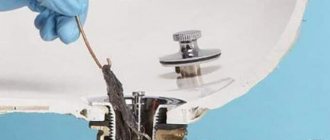Signs of a clogged drain
Before you think about how to clean the sewer, you need to identify the causes of the blockage and the place of its formation.
Obstacles to the normal drainage of water can form in the form of accumulation of lime, grease or inorganic objects (paper, rags). Signs of clog formation will help you deal with the problem. Thus, the need to take measures to clean pipes is confirmed by the following signs:
- unpleasant odor detected in the area of drain holes in the bathroom or kitchen;
- water flows out of the sink or bathtub at a lower rate than before;
- The water level when flushing the toilet tank is higher than normal.
If at least one sign is detected, action should be taken. Clogged sewer pipes occur for the following reasons:
- fat frozen on the inner walls of the pipes narrows the working diameter. Residues of food, hair, and debris stick to the fatty layer, resulting in the passage being completely clogged;
- settling of solid inorganic sediments inside the pipe. Often such blockages appear in places where the installation height of pipes in transition bends changes;
- In addition to grease, soap solution or remnants of washing powder from the machine may settle on the inner walls. Together with food waste, soap lingers on the inner surface, forming a plug;
- severe contamination is formed by the interaction of fatty accumulations inside the pipes and hair or animal hair that gets into the drain holes. Such blockages can only be removed using chemicals or mechanical action;
- violations in the installation of sewer pipes in an apartment or autonomous system. An insufficient slope angle of the drain provokes fluid retention in certain areas, where an accumulation of food debris, grease and debris forms;
- Hard water is often the cause of blockages. Excess lime in such water is deposited on the walls of the pipes, gradually reducing the working diameter. It is difficult to effectively combat this process; usually it is necessary to completely change the pipes;
- dumping large organic and inorganic objects into the toilet also causes blockages in the drain. Food waste and low quality toilet paper should be disposed of in another way;
- in autonomous systems, sewer pipes can be affected by external factors. Tree roots, rodents, and soil movements contribute to disruption of normal operation.
Is the sewer pipe clogged? Removing congestion quickly
We do not encounter blockages in the sewer system as rarely as we would like. Fat and food residues are drained into the kitchen sink. Toilet paper is thrown into the toilet.
Hair and debris get into the bathroom. We don’t know what the neighbors dump and dump. If they do not really follow the rules for using the sewer, then a blockage of the sewer riser may occur. Residents of high-rise buildings rarely encounter such a problem, but they do occur. It is relevant for the first floors. How to clean a sewer riser?
Determining the location of the blockage
To decide how to clean sewer pipes at home, you need to find out the cause of the problem and locate its location. To do this, you need to spill separate sections of the pipeline.
The check starts from the toilet. If, when emptying the toilet cistern, the liquid flows away without problems, go to the bathroom.
If the liquid from the bathroom passes well, move to the kitchen. Here, traditionally the blockage occurs in the siphon, but it is also possible for waste to accumulate in the pipe connecting the kitchen sink drain and the main sewer pipe.
If the liquid does not drain at all, but flows from the sink into the bathroom or raises the level in the toilet, the problem is in the general house system - the riser is clogged.
When a problem arises in a private building with a separate septic tank, the first thing to do is check the water level in the receiving pit or septic tank. If it does not exceed the permissible level, then the problem is in the sewer pipes at the exit from the cottage.
A particularly unpleasant situation is when a rag or other object gets stuck in the main sewer pipe of an apartment building, at a level just below your floor. Then all the sewage from the apartments on the upper floors will enter your sewer system and spill over the edge.
In this case, you will have to call plumbers with special equipment. It is impossible to fix this problem on your own.
The sewer riser is clogged: what to do?
If a sewer riser in an apartment building becomes clogged, the management company of the building must organize its cleaning and repair.
You pay monthly for the services of your management company through a Unified Payment Document or, more simply, a receipt for the apartment. Utility services for the building, including emergency ones, are formally already prepaid by you and the management company does not have the right to demand any additional payments from you if the riser is clogged. If an accident has already occurred, the management company orders the elimination of its consequences from the SES and independently selects specialists who will have to repair the damage to the pipeline. This entire process occurs without the direct participation of the residents of the house.
Note!
The management company only services common property; in any case, you will have to organize and pay for sewerage cleaning and repairs on the territory of your apartment yourself.
When a common sewer riser in a house becomes clogged, the consequences can literally spill out into your apartment, what should you do in this case?
- Don't use the sewer.
- Turn off the washing machine if it is currently washing.
- Turn off the water in the apartment.
- Visit your neighbors upstairs and downstairs to see if they have similar drainage problems.
- If sewage flows through the toilet into your apartment, you will have to scoop it out with a bucket for a while and pour it into the bathtub with the drain previously closed.
In the latter case, your time is actually limited by the volume of the bathroom, so if there is a sewage spill, immediately call the emergency SES service to your apartment. After this, you can call the control room of the management company and report an accident in the house. Her phone number is listed on the EPD payment. While the emergency service from the management company will solve the problem in the house, the SES will save you from the consequences of a sewer eruption in your apartment.
Helpful advice.
If you live on the lower floors of an apartment building and periodically experience flooding, you can install check valves on the toilet, individual drains, or the entire apartment sewer system as a whole, allowing you to shut off the apartment pipes in the event of an emergency.
To eliminate the consequences of general blockages in your apartment, you can contact SES Dez Group, certified by Rospotrebnadzor, with more than 13 years of experience. The work is performed for you by specialists with experience from 7 to 30 years in their fields, all services are provided with an official guarantee under the contract, and the result of cleaning the sewerage in the apartment
noticeable immediately after the end of the procedure.
SES "Des Group" also cooperates with management companies and helps eliminate blockages and the consequences of accidents in public sewer networks.
Methods for cleaning sewer pipes
Descriptions of the following options for dealing with blockages will help you figure out how to clean a sewer pipe yourself, using traditional means and mechanisms.
Cleaning with a plunger
You can quickly remove the blockage using a plunger, which can easily deal with minor seals in the sewer system.
Water is drawn into the drain hole of the sink or bathtub, then the rubber part of the plunger is pressed tightly, closing the hole. When working with a plunger, the main thing is to ensure that the rubber is firmly fixed and to prevent leaks and air from entering.
Having achieved the desired position, begin cleaning the pipe. To do this, make sharp forward movements with the handle of the plunger towards the drain hole.
To break through the blockage, you will need to make at least ten clicks. For final cleaning of the pipe, the procedure is carried out 2-3 times.
Mechanical cleaning
For mechanical cleaning of sewers in a private house or apartment, special equipment is used. In this case, it will be difficult to carry out the work yourself, since most likely you will have to partially dismantle the pipes.
The mechanical method removes blockages with a low degree of hardness.
Hydrodynamic cleaning
Sewer cleaning using the hydrodynamic method is carried out using special equipment that supplies water under high pressure. At home or in a country house, you can use a Karcher car wash installation.
Hydrodynamic nozzle.
Hydrodynamic sewer cleaning is carried out with a powerful stream of water, which breaks through the blockage, carrying the remaining pollution into the riser. This method allows you to thoroughly clean the inner surface of the pipes.
Due to the complexity of performing this work, as well as the need to use special equipment, the method is used to remove serious blockages. Specialists are most often called in to clean sewers using the hydrodynamic method.
Using a cable
To clean the sewer using a cable, perform the following steps:
- Find an inspection plug designed for cleaning pipes. If there is no such plug, the cable is inserted through a pipe in the kitchen, having first unscrewed the siphon.
- Before cleaning, the cable is rolled into a skein. This way it will be more convenient to gradually move it inside the sewer.
- The end of the cable is inserted into an inspection hole or into a pipe in the kitchen. By pressing on the cable, it is pushed deep into the pipe.
- In order to thoroughly clean not only the blockage, but also the inner surface of the sewer pipe, while pushing the cable, it must be rotated around its axis clockwise. For this purpose, a handle is provided at the end of the cable.
- During the process of cleaning the pipe, the cable is periodically removed and freed from adhering particles of dirt and grease. When pulling the cable, perform a reverse rotational movement, counterclockwise.
- You need to clean the pipes with a cable at least three times.
- After removing all large particles from the walls, you need to rinse the pipes with a large volume of hot water.
Washing with boiling water
A popular way to quickly clean pipes from accumulated grease and food debris. To effectively treat the inner surface of pipes, you will need:
- boiling water in a volume of at least 10 liters;
- 400 grams of baking soda.
Soda is dissolved in boiling water, after which the homemade product can be poured through the drain in the kitchen or bathroom into the sewer.
To enhance the effect of hot water, it is recommended to use a plunger, pumping the liquid under pressure inside the pipes.
When using a plunger, you need to plug the overflow hole. A gloved hand is placed over the overflow and blocks the flow of water.
Use of chemistry
The chemicals used for cleaning pipes include caustic soda (Mole, Tiret). This compound eats away plugs of food debris, hair and fat. The solution must be poured into the drain hole in the kitchen or bath and left for the time specified in the instructions. Afterwards, the pipes are washed with a stream of hot water.
In some cases, when a chemical is based on hydrochloric acid, the solution must be diluted in a certain proportion with water.
Cleaning with soda
To dissolve fatty deposits in pipes, use regular baking soda. This cheap product helps to deal with blockages in the siphon without disassembling it. You need to pour 100 grams of soda into the drain hole and pour boiling water over it. Fat, under the influence of boiling water and soda, will dissolve, freeing up the passage for draining.
This method also helps get rid of the unpleasant odor in the siphon.
If the blockage is deeper, prepare a special solution of soda and water. Before preparing the solution, you need to heat the soda in a frying pan. To prepare an alkaline mixture based on soda ash you will need:
- baking soda -150 grams;
- water – 200 ml.
Heat the soda in a frying pan or baking tray for 15 minutes. Once smoke begins to form above the powder, stop heating. This process turns baking soda into soda ash.
The powder must cool to room temperature, after which it is mixed with water. The prepared solution is poured into the drain hole for 20-30 minutes. Afterwards, the pipe must be rinsed with hot water.
In addition to baking soda, water solutions with vinegar and salt can be used at home, but they are less effective. The use of caustic soda for cleaning drains at home is not recommended. This reagent is used in industrial enterprises.
How to properly clean a drain at home
The sewer system is a headache for many compatriots, especially those living in houses built a long time ago. From time to time, blockages inevitably occur, caused by a variety of reasons. Most often, the formation of a blockage is largely our fault when an insoluble object gets into the drain system. But the sewage system itself deteriorates from long-term use, the diameter of its pipes narrows, and various substances, pieces of fat and other organic elements settle on the walls.
Today we will try to figure out how to properly remove sewer blockages at home, how to clean the sewer without resorting to the help of plumbers, with your own hands, which means can be most effective: chemical or mechanical.
Read Do-it-yourself drainage well for sewerage
Something is definitely wrong with the sink drain.
There are a number of ways to save on utility bills.
- How to legally save up to 60% water in a month.
- How to pay 2 times less for electricity.
- How to reduce gas consumption by 40%.
For obvious reasons, blockages always happen at the wrong time, and there is no time when they would be appropriate. On any weekday we are busy with work, and on weekends we want to relax and not mess around in our own and other people’s feces. But if a blockage occurs, if the riser does not work and there is water in the bathtub or kitchen sink, you will have to take measures, and first identify the causes of the problems that have arisen.
Conventionally, all blockages that appear in the apartment can be divided into several types:
- A mechanical blockage is the creation of your own hands when you flush a dense object in the toilet that does not dissolve and does not pass through the pipe, but tightly blocks the riser.
- The accumulative clog does not appear immediately; it accumulates on the walls of the sewer pipe for a long time. Usually it is based on fats, to which other substances already stick, blocking the flow of water through the pipe. This is the easiest clog to remove and is most effectively washed away with soda and vinegar.
- A so-called siphon clog can be the result of a large amount of grease being flushed down the sink at the same time. which blocks the water. Such a blockage is also not particularly dangerous and can be easily removed with chemicals, or the same soda and vinegar.
- Installation blockage occurs due to the fault of careless plumbers and designers who incorrectly designed or installed the sewer system. Such problems usually occur among residents of private cottages, so it may be impossible to clean the sewer system in a private house without redoing it.
To begin work to eliminate the problem, it is necessary to accurately identify the location of the blockage, for which it is important to check the riser in the kitchen, bathroom, see if the water is draining in the sink in the kitchen, bathroom, and how the toilet functions. In addition to local blockages, the main pipe through which wastewater flows from your apartment into the general collector may be clogged. This pipe can be cleaned from several places.
Obvious problems with toilet plumbing
Local blockages that occur in the apartment can be cleaned with your own hands, and quite quickly and effectively. But if the main pipe of the entrance sewer system is clogged, then residents of the lower floors can have very serious problems. All wastewater from the upper floors, instead of leaving the house, will flow through the pipes of the lower floors; waste will begin to flow out of the sink drains in the kitchen, bathroom, and toilet.
If such an unpleasant situation arises, you need to immediately call special services and notify the housing office in order to solve the problem as quickly as possible and clean the main riser of the house. Delay can have a detrimental effect on your renovation and plumbing in the bathroom, kitchen, and toilet. But let’s not immediately rush to extremes, but move on to consider ways to clear local blockages at home that have occurred in our apartment, which we can overcome with our own hands.
Choosing the optimal method depending on the location of the blockage
The cleaning method depends on where the blockage occurs.
If a blockage occurs in the siphon , mechanical cleaning is used, namely, the device itself is disassembled, dirt is removed, washed and installed back.
Small blockages inside the sewer pipe in an apartment can be removed using a plunger or chemicals. You can also use the hydrodynamic method.
If a heavy coating of grease , mechanical cleaning with a cable will be required.
When large blockages occur in the riser , it is correct to call plumbers with special equipment to mechanically clear the blockage.
We check and clean siphons
The first barrier to various clogging objects in your plumbing fixtures is the siphon. It is a device that performs two functions:
- Creates a water barrier that prevents the penetration of unpleasant odors from sewage into residential premises. The water seal is constantly updated; a new portion of water enters it after each use of the plumbing fixtures.
- The siphon also has a kind of trap that traps heavy small particles, preventing them from penetrating into the sewer pipe.
If you find that water is stagnating in your sink or bathtub, then at the initial stage you need to check the capacity of the siphon. This device is very easy to remove and disassemble - all its components are fixed to each other with threaded connections. When disassembling the siphon, a certain amount of water may spill out of it - so do not forget to place a basin under it or, at worst, put a rag.
Step 1 - check the siphon for blockages
After disassembling the siphon, you can immediately determine whether there is a blockage in it that is preventing the passage of wastewater. Remove foreign objects and rinse the siphon in a bucket of water or under running water, then reassemble the entire device in reverse order.
Methods for preventing blockages
Sewer pipes will always clog, because... The accumulation of fats and food waste inside the pipes cannot be completely avoided. But there are rules to prevent large blockages. To keep pipes clean, the following preventive maintenance must be performed periodically:
- Protective plastic nets must be installed on drain holes in the bathtub and kitchen. Removable nets will retain large particles of food and dirt, and hair. This catcher is easy to clean and put back in place. This is the easiest way to keep your sewer pipe in order;
- Do not pour oil waste into the drain hole after frying. Before washing such dishes, you need to fill them with hot water, add detergent and let them sit for 10-15 minutes. After this, the dishes are rinsed with hot water and washed;
- After washing dishes with an abundance of greasy residues, do not run cold water. Grease settles on the walls of the pipes and, if not washed off with hot water, it hardens and contributes to the accumulation of other waste. As a result, traffic jams form;
- the owner himself must periodically clean the autonomous sewer system using chemical flushes or caustic soda. Preventive cleaning will help protect the system from major blockages;
- an unpleasant odor from the drain holes warns of waste accumulation on the walls of the pipes or in the siphon. The smell will persist if you do not clean the pipes using chemicals or folk methods;
- In an autonomous sewer system, toilet paper should not be thrown into the toilet. Only natural waste should go into septic tanks.
What are blockages and the causes of their occurrence?
It may seem strange to a non-professional, but blockages also have their own classification:
- Operational blockage. With such a blockage, fat settles on the inner surface of the pipes and over time attracts not only more fat, but also small mechanical debris.
- Mechanical blockage. The cause of this type of blockage is a foreign mechanical object in the sewer system.
- Siphon blockage. The causes of blockages are different, but with this type of blockage, home siphons cease to perform their function.
- A man-made blockage occurs when there is a possible error during the installation or design of plumbing equipment.
It is worth remembering that before starting to repair a riser or plumbing equipment, you need to thoroughly know where the accident occurred.
How and with what to determine the location of the blockage?
If the sewer is clogged, you must first determine the intended location. In a private house, we will conditionally divide the entire system into two zones: the house and the street.
In the house you should pay attention to the following places:
- In the siphon under the sink in the kitchen and bathroom.
- In a corrugated pipe under the washbasin.
- At the exit of the riser to the street.
- At the connection of smaller pipes with a larger diameter.
There may be such places on the street:
- At the outlet of the pipe in the septic tank.
- On the section between the wells.
To determine the exact location of the clogged system, you will need to check for water drainage at different points. This way you can understand where the congestion is. Using this principle, other possible clogging locations are determined.
Start by unclogging your sink or sink drain.
Most often, the drain in the kitchen or bathroom becomes clogged. It is there that there is a lot of fat and small debris (food debris, hair) for objective reasons. The sooner you start a “war” for the free passage of water, the better. To get started, follow these simple four-step instructions:
- Boiling water. If the pipes are steel or cast iron, then you need to pour about 1 liter of boiling water into them. If they are plastic, then just run hot water from the tap in a small stream for about 20 minutes. This is an ideal way to dissolve a bar of soap that has fallen into the drain.
- Soda and salt. Add ½ tbsp to a glass of water. salt and 1 tbsp. soda, mix well and pour into the drain. After 10–15 minutes, clean it with a plunger or a rag folded into a tight ball.
- Vacuum cleaner. Quite an unusual step, but very effective. The only condition: the vacuum cleaner must have a blowing function. You need to seal the vacuum cleaner pipe with a rag and insert it into the drain. When turned on, a strong air flow will push through the resulting plug.
- Clean the siphon. To do this, remove it and, having thoroughly cleaned the inside of debris, rinse it with running water.
Why do the pipes in the kitchen get clogged?
In everyday life, blockages most often occur in the pipes coming from the kitchen sink; they are caused by the following factors:
- The kitchen sink is mainly used for washing dishes and cooking utensils, so if the pipe is clogged, the first cause of the problem is food residues.
- Kitchen drains also become clogged with grease deposited on the inner pipe casing after washing dishes and food. Dirt and small organic waste stick to it, narrowing the passage channel and slowing down the flow of gray water.
- Incorrect installation of the siphon, a large number of bends or insufficient slope of the drain pipeline, its physical wear and tear can cause frequent blockages.
- Improper operation using predominantly cold water in the sink, lack of preventive cleaning and rinsing are the reasons why the sewer often begins to clog.
Rice. 2 Principle of hydraulic cleaning
Helpful flowchart for clogged sewage
Covering scheme in the house.
- Fan.
- Sewer channel.
- Kitchen.
- Bathroom.
- The blockage at this point blocks the separation from the toilet and washbasin.
- Washing machine.
- Blocking at this point prevents leakage from the sink.
- The obstructions prevent the drainage of all waterworks on the upper floors.
- Solar roof for cleaning sunbathing areas.
- The locking block blocks the drain for the entire house.
- General sewerage for wastewater.
How to eliminate unpleasant odor from a drain
It is logical that to eliminate the smell, you need to remove the cork - the cause of the spread of bacteria that provokes a disgusting odor.
In this case, simple tricks will help:
- Pour dry mustard into the drain, add hot water, leave for 10 minutes and rinse.
- A liquid bleach solution will also effectively eliminate the smell, although it will overpower it - not pleasant for everyone.
- Air fresheners are a quick way to eliminate the unpleasant smell from the drain, however, the problem will only be solved for literally a few hours.
The clog is usually accompanied by an unpleasant odor from the drain.
Sometimes the cause of an unpleasant smell from the drain may be the lack of a water seal - a kind of water lock that prevents the smell from escaping from the sewer into the apartment. A siphon provides a water seal in the sewer system. Incorrect installation of the latter can cause odors to enter the rooms.
The solution to the problem depends on the type of siphon:
- If the siphon is a bottle type, then it is necessary to adjust the location of the drain pipe so that it is two to three centimeters below the water level. Otherwise, the evaporation will pass over the water lock.
- If the siphon is a pipe siphon, then perhaps the drain pipe has straightened out for some reason or was initially installed incorrectly. In this case, it just needs to be given the desired shape to ensure the formation of a normal water seal and fixed in this position with special clips.
Removing blockages mechanically
Even the most aggressive solution sometimes cannot cope with some mechanical causes of blockage. Of course, a soda solution will have no effect on rags stuck in the pipes. In this case, mechanical cleaning of the blockage is used.
The simplest tool for this type of work is a plunger. The principle of its operation is this: it creates pressure in the system, and the water itself pushes the rag further along the riser. If there are branches in the system along the way to the site of the blockage, this may impede the action of the plunger. In this case, nothing will help except a plumbing cable.
The plumbing cable is not a high-tech invention of engineering. This is a simple but very effective tool. It is a metal cable with an L-shaped handle at one end and a tip or a spiral nozzle at the other. This nozzle not only acts as a battering ram, but can also be used to remove stuck items from the sewer.
